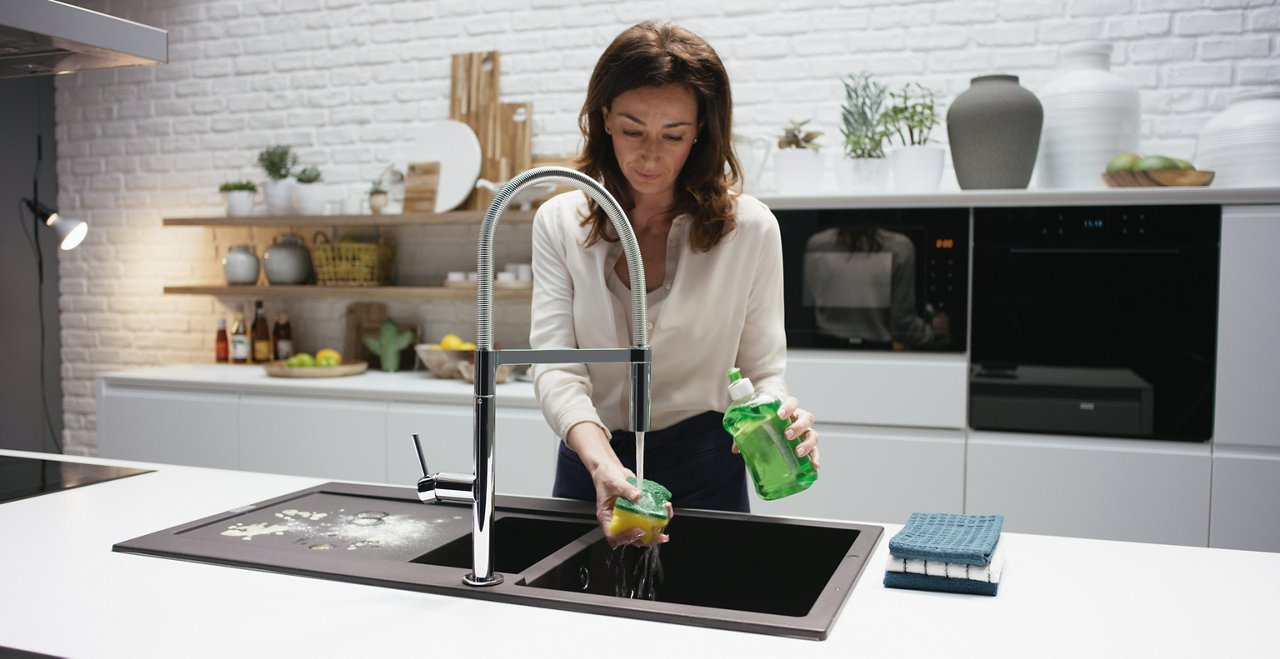CLEANING AND CARE FOR FRANKE GRANITE SINKS
HOW TO MAINTAIN YOUR SINK
• The basis is frequent and regular cleaning of the sink. Even if it is not thorough, regular cleaning is more appropriate than just occasional thorough cleaning of the sink. The best maintenance of the sink is frequent washing of dishes. With a granite sink, common liquids, creams, pastes and dry powders can be used for regular maintenance.
• The perfect appearance of your sink can be affected by water quality. In areas with hard water, gray or otherwise colored stains may appear on the sink. These are really just layers of water deposits or minerals that commonly occur in hard water areas. These minerals then easily absorb substances that leave stains, such as tea, coffee, red wine, foods with high color pigmentation, etc., thus spoiling the appearance of your sink. Therefore, you should wash and dry the sink after each use. If deposits remain on your sink, use a descaling agent (not a waste cleaner). You can also use a mixture of one part vinegar and three parts water, leave on for several hours, preferably overnight. Then thoroughly remove the residue with a sponge and sink cleaner.
• Use a soft cloth or sponge and dishwashing liquid to remove daily traces of using the sink. Use a sponge and active cleaner to remove remaining stains.
• If stains are very difficult to remove, especially recommended for light-colored sinks, fill the sink with a mixture made up of 40 parts water and 1 part bleach (eg laundry stain remover) or biological detergent and leave on overnight. Then drain the sink and rinse thoroughly. This method is definitely not intended for daily cleaning of the sink. In case of prolonged neglect of maintenance and subsequent graying, yellowing of the bottom of the sink (limescale deposition), descaling is a longer-term matter.
• Your sink is made of an extremely durable material. Be careful, if you move metal pots and pans over its surface, they may leave metal marks. However, they are only on the surface of the sink and you can remove them in a circular motion with the rough side of the sponge and a sink cleaner.
• Try to avoid dropping sharp objects into the sink, which can chip or damage the surface.
WHAT TO AVOID
• Always avoid the use of metal cleaning sponges and scouring pads, as their metal parts stick to the surface of the sink. Do not leave steel and cast iron kitchen utensils on the surface of the sink for a long time. However, if there are stains on the surface, you can remove them with a sponge and sink cleaner.
• Do not leave plastic sink pads, damp cleaning sponges and cloths in the sink overnight, as they retain water underneath and inside each other, as a layer of limescale may form on the surface of the sink.
• Make sure that the sink does not come into contact with concentrated bleaching agents or products containing chlorine active substances (paint removers and brush cleaners), acids (descaling agent for kettles), caustic soda (waste cleaners) or with oven cleaners and carbon dioxide-containing agents. The use of these agents causes discoloration of the sink material and permanent irremovable stains, or surface etching.
• The sink is short-term resistant to temperatures up to 280 °C (10-15 seconds) and no damage should occur. However, we do not recommend using the sink as a storage space to cool cooking pots. Use a separate storage area and mat for this purpose. Do not pour hot oil into the sink, as this may damage the surface. Hot oil has a much higher temperature than 280 °C.
• Do not use the sink to cut food.


